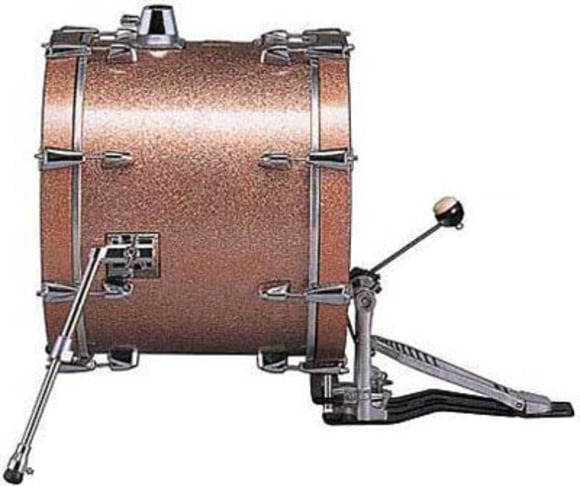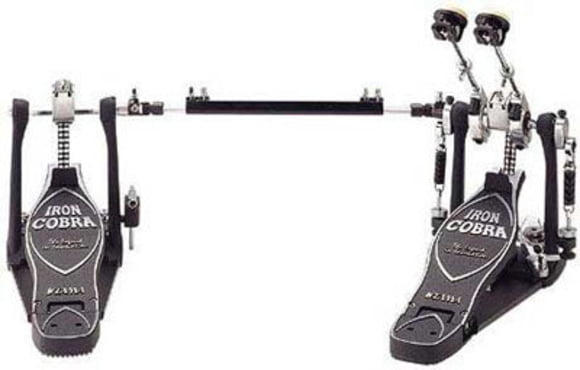3. Bass Drum and Bass Drum Pedal
The bass drum, sometimes referred to as kick drum, is the largest instrument within the drum kit. It plays an important role, because it usually defines the beat with the snare drum. In many styles of music, it provides a solid, strong foundation, which interacts with the bass part to form the basic groove. Bass drums come in many sizes. While some jazz drummers prefer small bass drums (sometimes almost as small as a floor tom), rock music is dominated by bass drum sizes of 22“ and up.

Bass Drum and Bass Drum Pedal
Bass Drum
The bass drum has adjustable legs on both sides of the shell. These should be sturdy, because they must withstand the impacts of the beater hits while carrying the weight of the Tom-toms, which are usually mounted on top of the bass drum if they're not attached to a rack system or the cymbal stands.
The batter head faces the drummer. On this side, the pedal is attached to the lower portion of the hoop. The resonant head is mounted on the opposite side. In rock music, the resonant head often features a circular opening. It is also common practice to place absorbing materials such as blankets or foam inside the bass drum. But why is this done – isn't the drum supposed to make sounds?
The reason is that the big and wide column of air inside an unmuffled bass drum with a closed resonator head can lead to a dull and ringing sound. By systematically muffling the drum, a more controllable, direct and „punchy“ sound may be achieved. Unfortunately, there is no single correct way of doing this – don't blindly follow instructions or cut holes into the resonator head if you're not sure what you're doing! It is important to carefully adjust the muffling to suit the drummer's preference and the room in which the drums are to be played. If you overdo it, you may end up with a drum that sounds more like a cardboard box. Some manufacturers offer pre-installed muffling systems, which make it easier to achieve the desired bass drum sound.
Single pedals
The bass drum is the only component of the drum kit which is exclusively played by foot. The bass drum pedal serves to place the beater in an ideal position on the drum head, and to deliver the striking action itself. Standard models like the ones typically included with starter kits usually have decent ball bearings and an average resistance. The beater is linked to the foot pedal with a chain drive (like a bicycle chain) or a plastic belt. Once you've become a more advanced player, you can experiment with different models to find out which ones best suit your foot technique and let you improve on it further. But most beginner's models offer reasonable room for adjustments, so that you can usually get away with putting this decision off for a while. The beater is generally interchangeable, which means that you can experiment with different beater materials without replacing the entire pedal. The sound can vary considerably with the firmness of the beater.

Double pedal
Double pedals
Double bass drum pedals are popular with advanced drummers, especially those who play harder styles like Heavy Metal. They let you play fast passages with both feet, for which you would otherwise need two separate Bass Drums. Some manufacturers offer expansion kits to turn their single pedals into double pedals, which means that you don't have to let your single pedal collect dust when converting to a double. In recent years, rigid direct drive systems (as opposed to traditional chain drives) have become a popular feature on double pedals.



